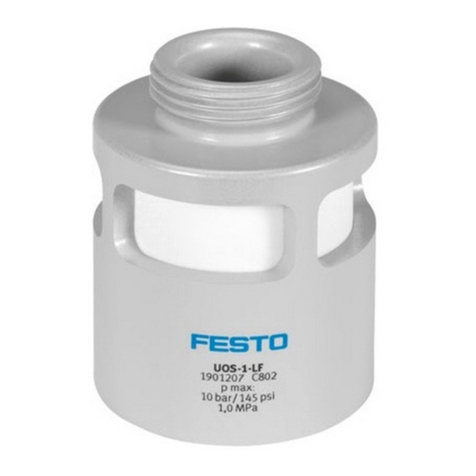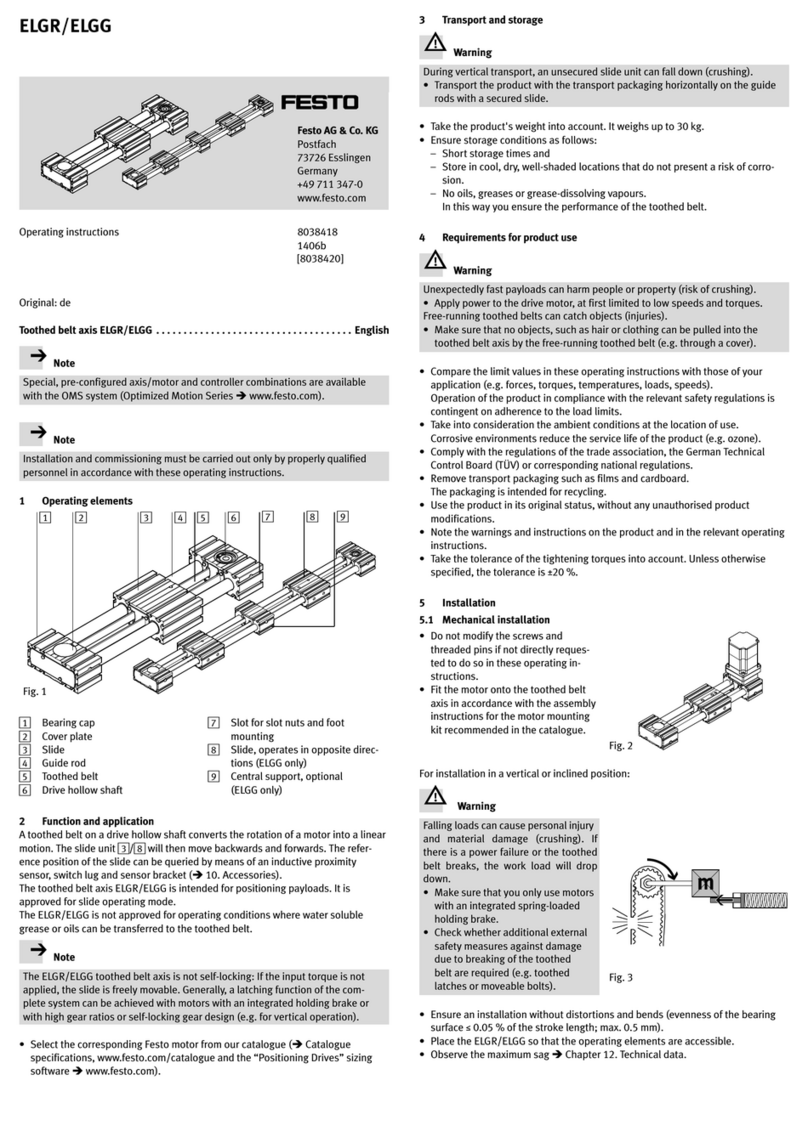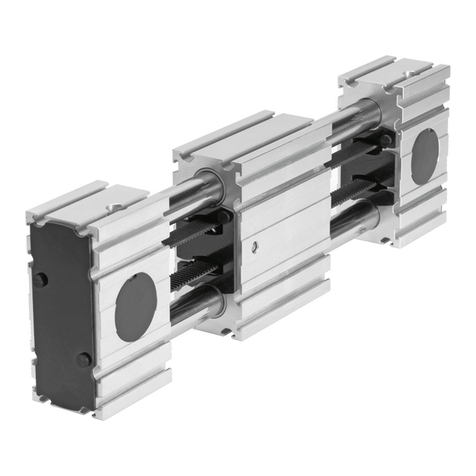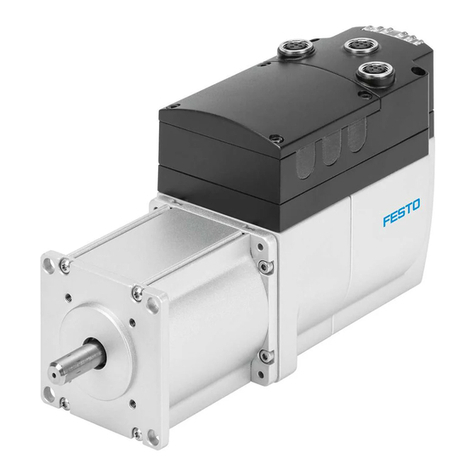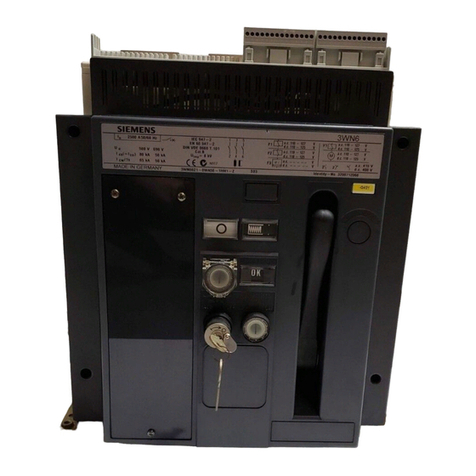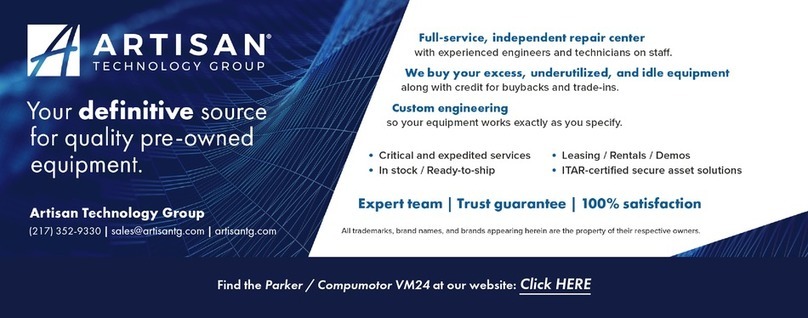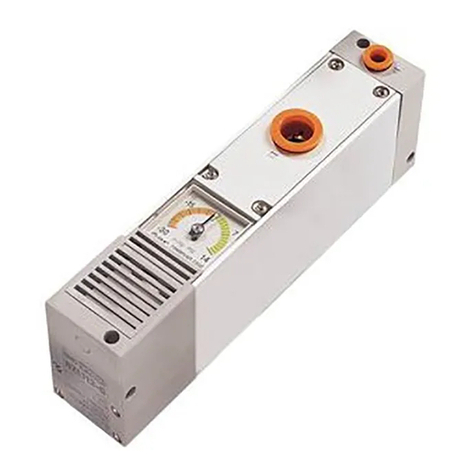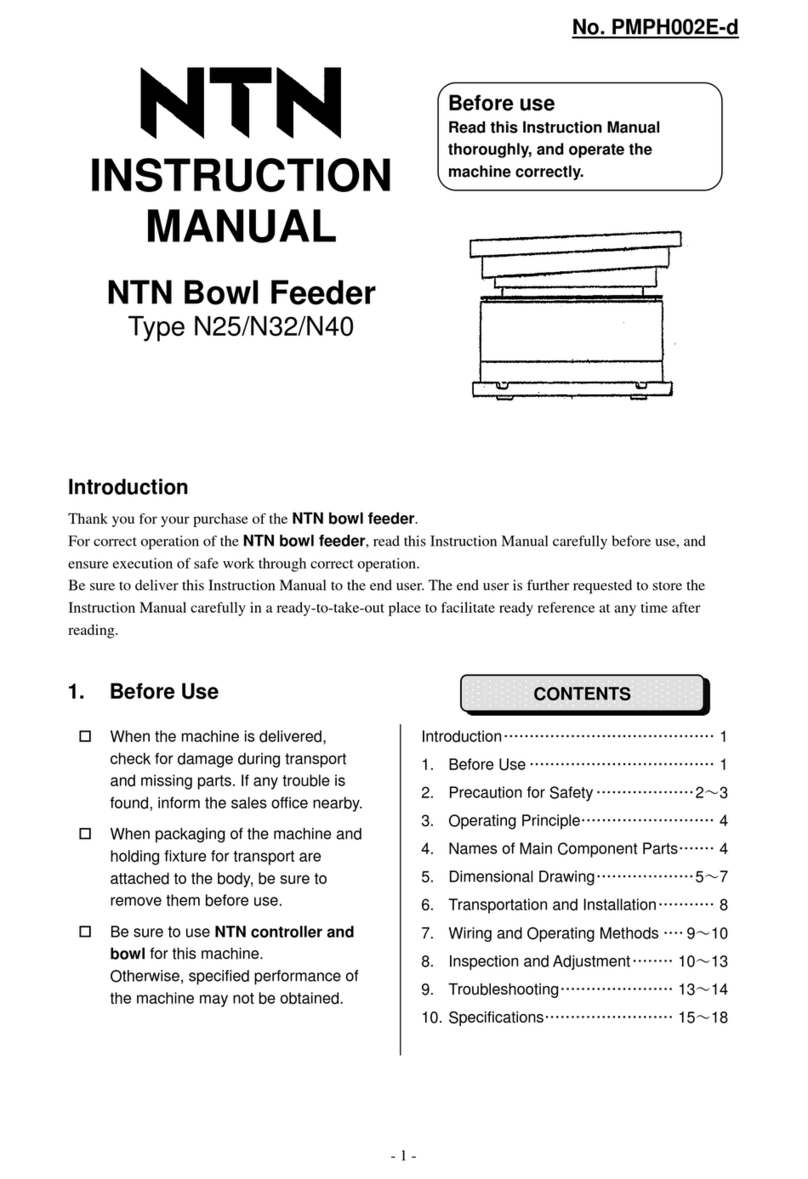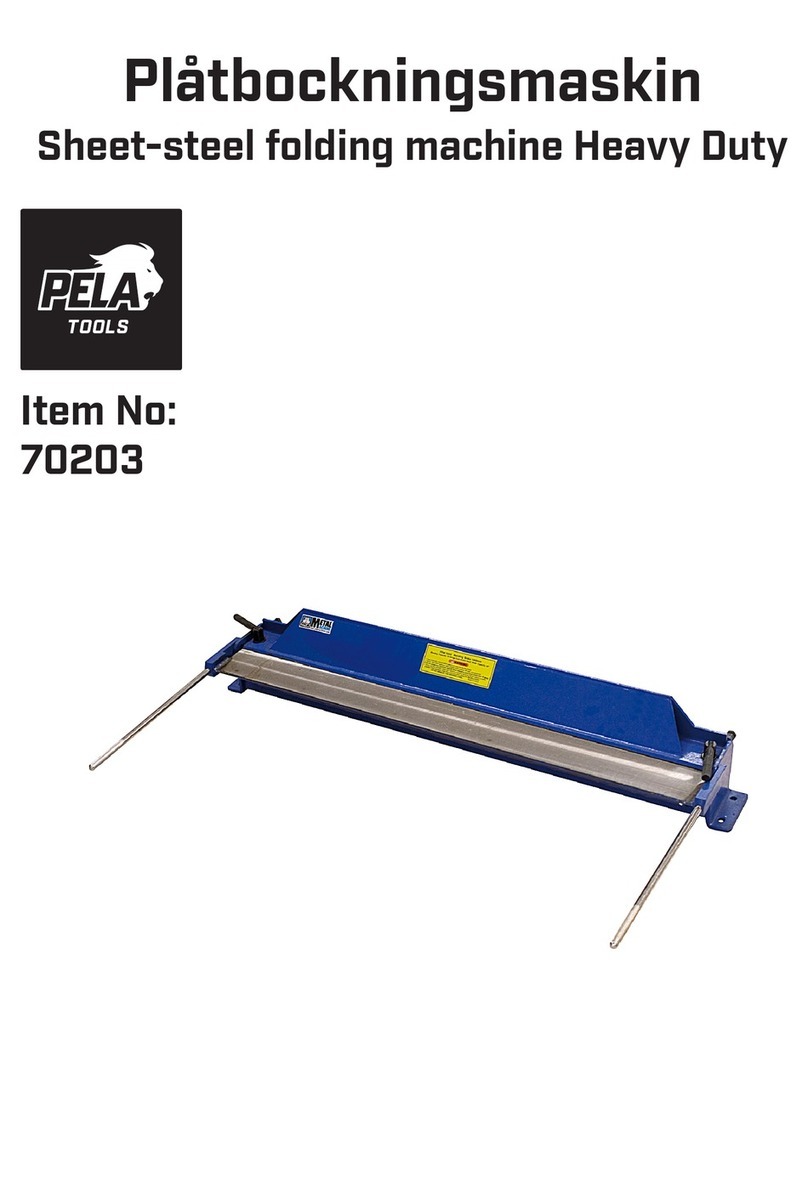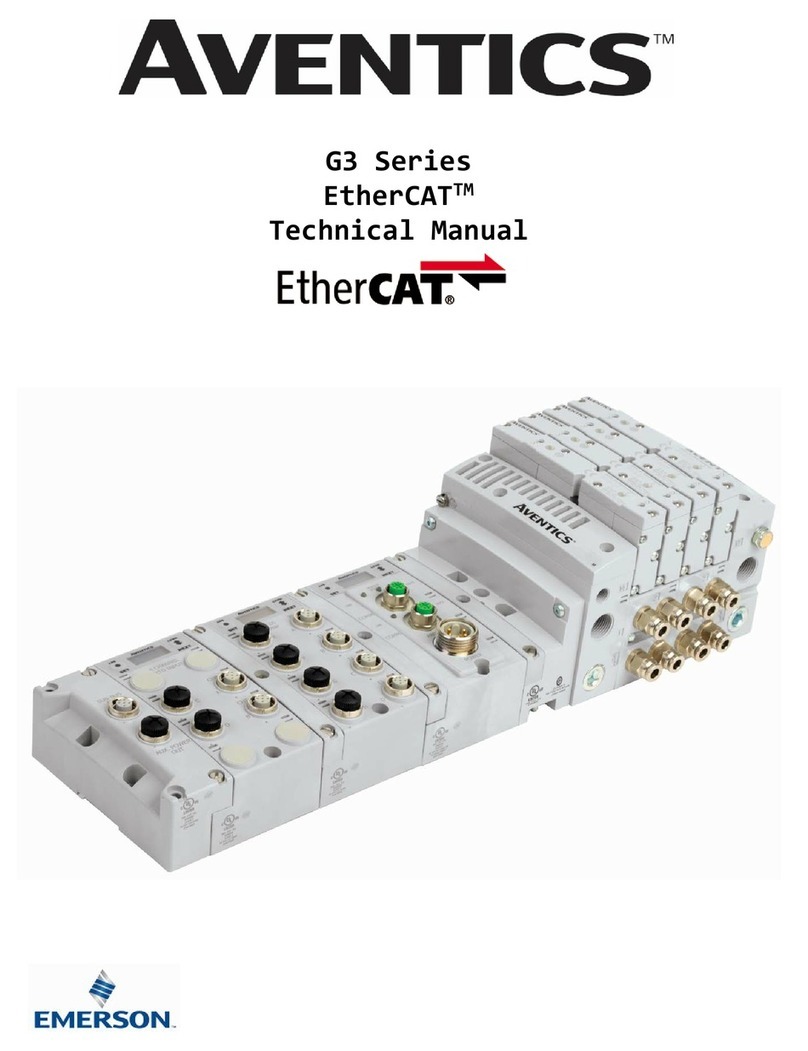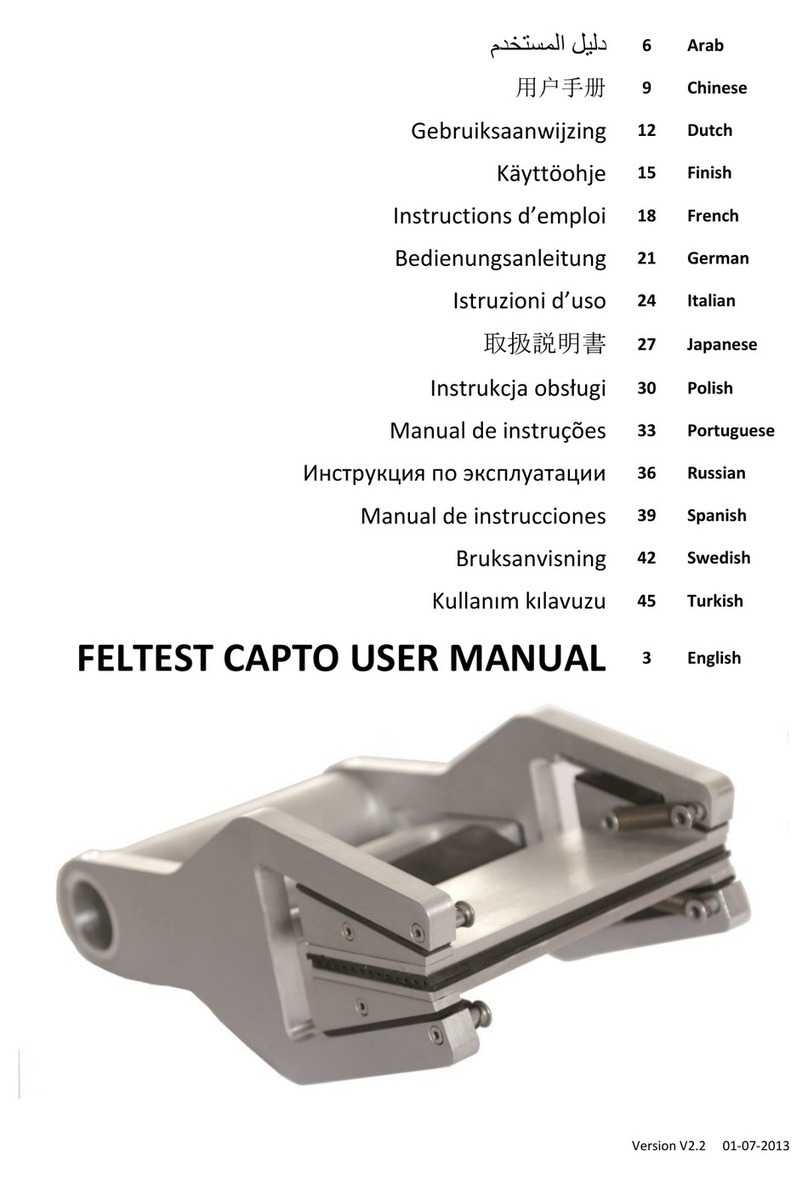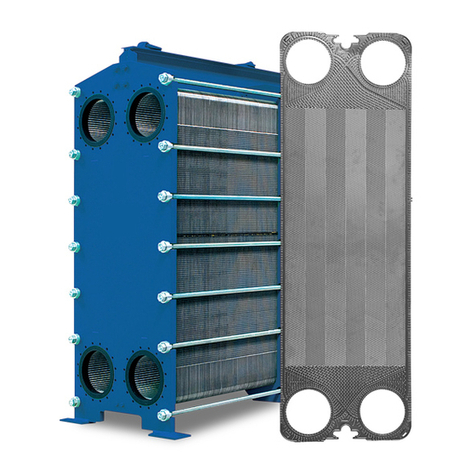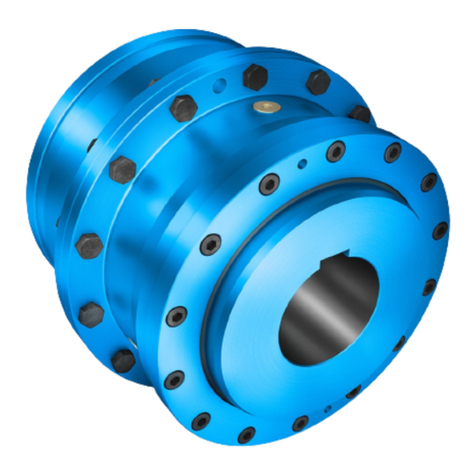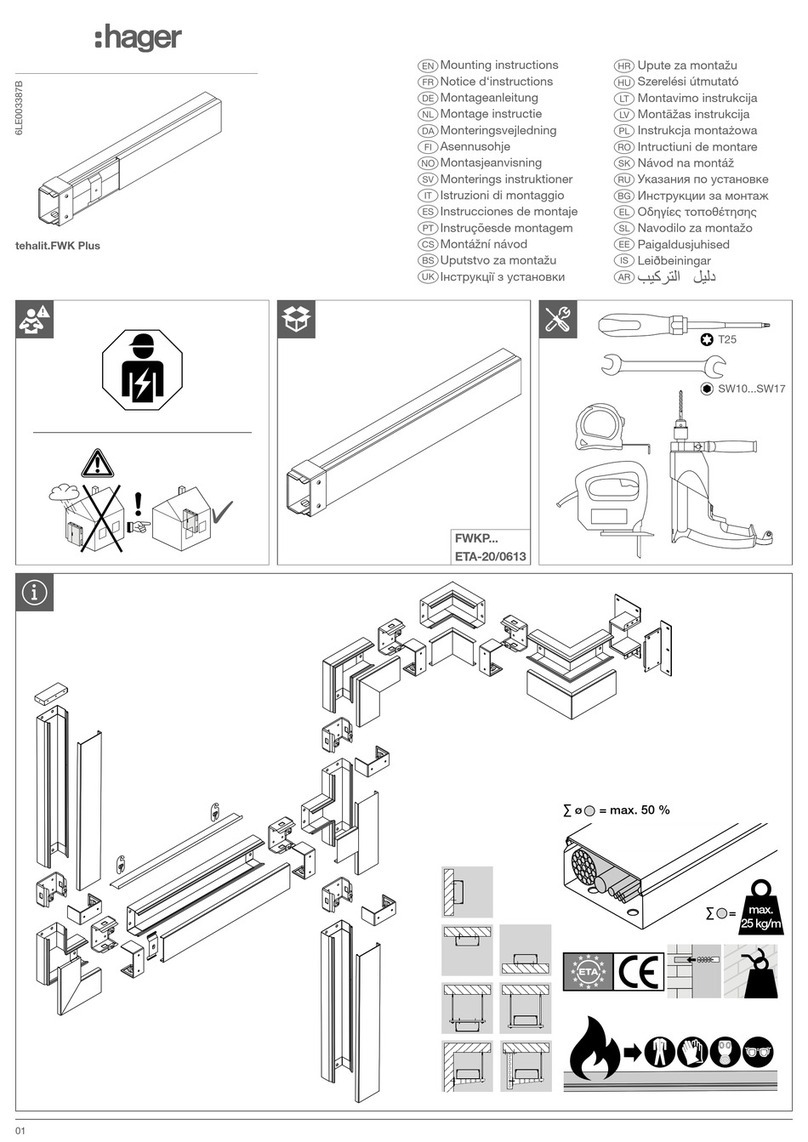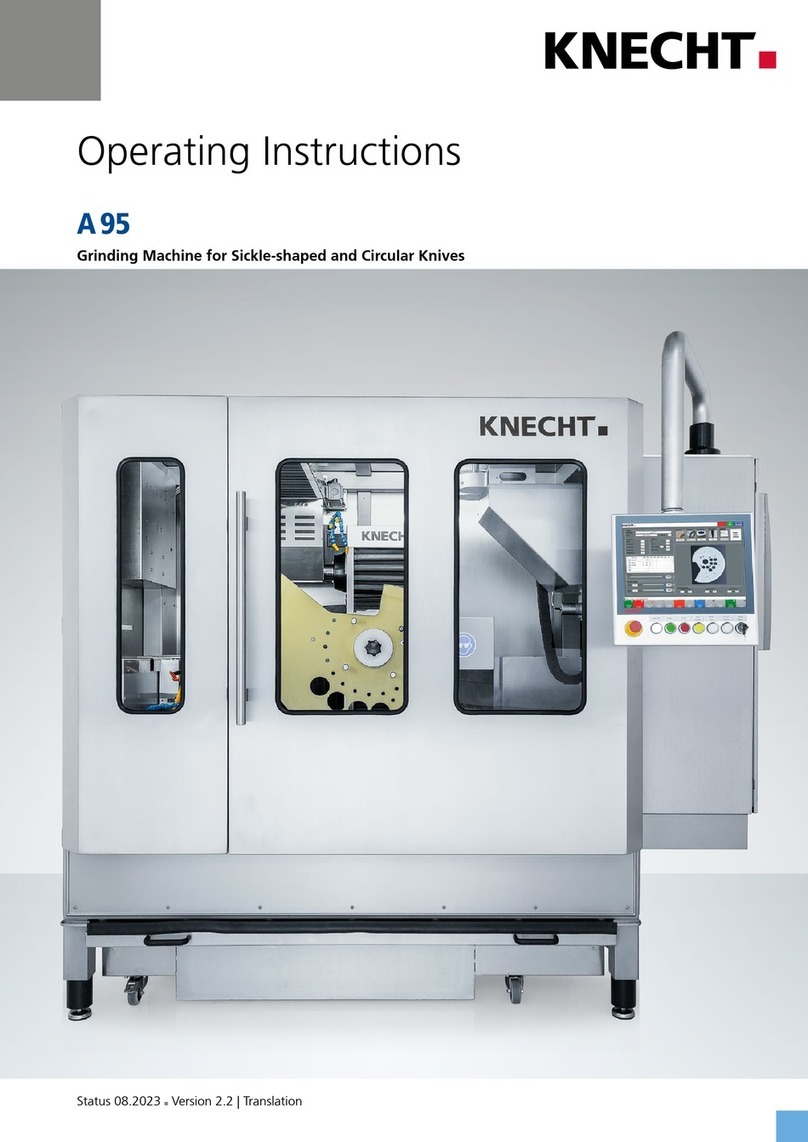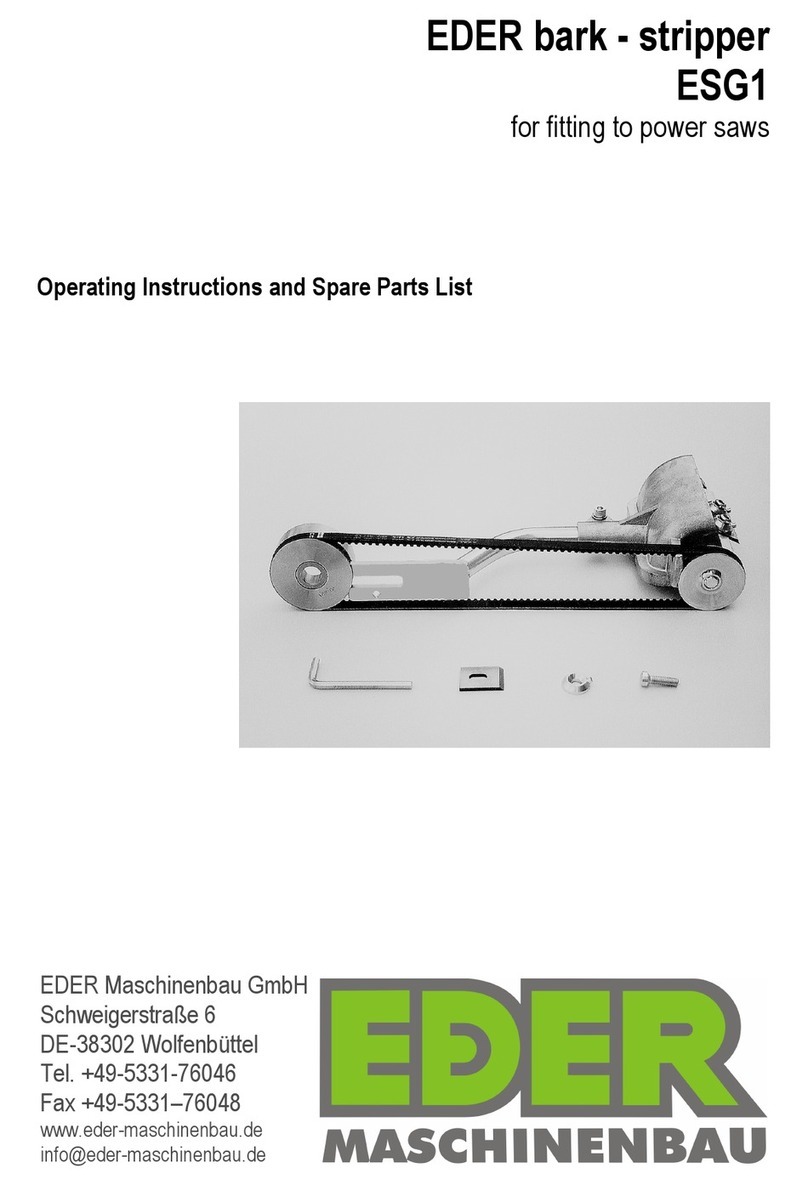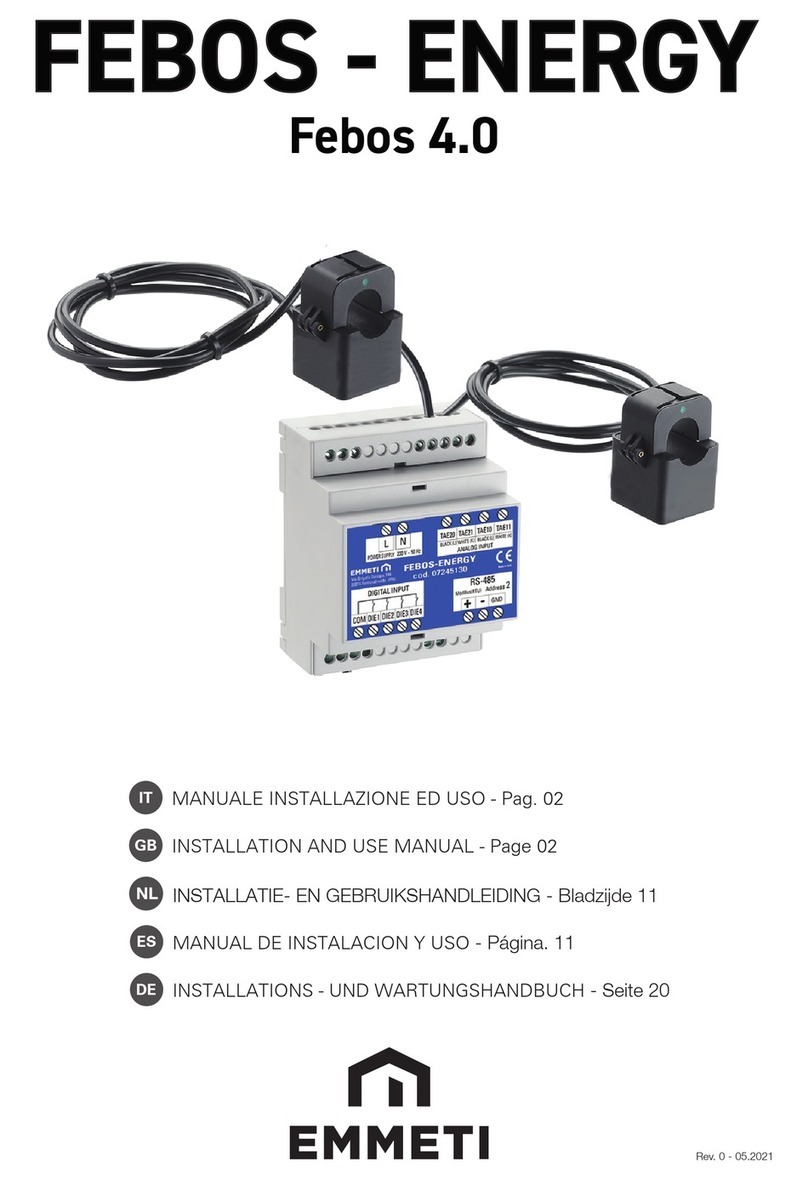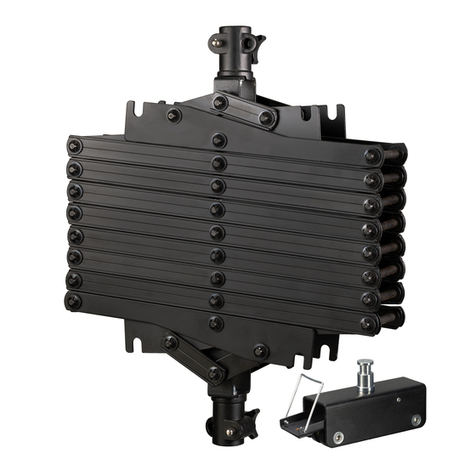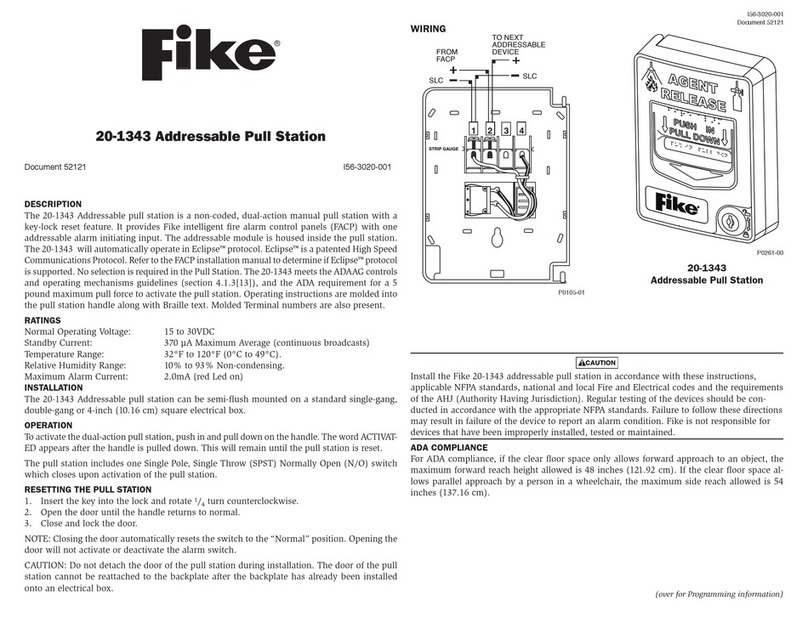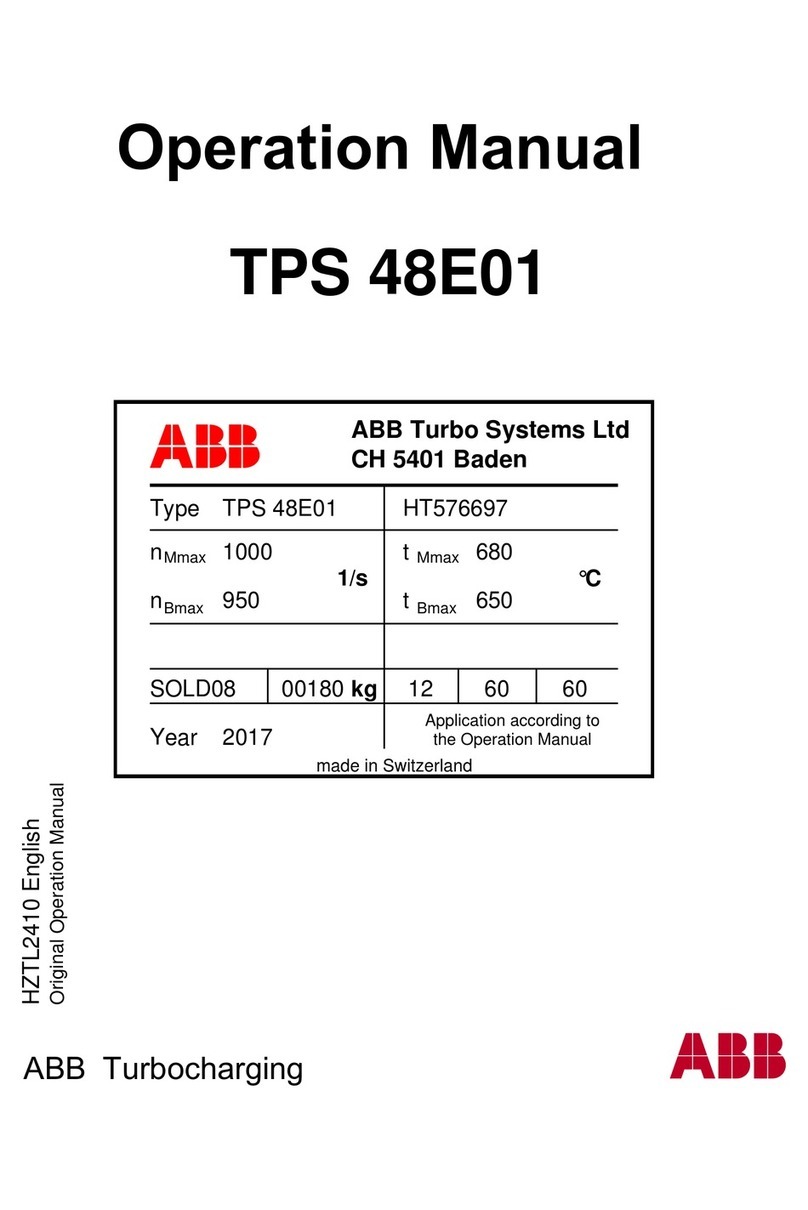Festo ELGC-BS User manual

ELGC-BS
Spindle axis
Festo SE & Co. KG
Ruiter Straße 82
73734 Esslingen
Deutschland
+49 711 347-0
www.festo.com
Operating instructions
8117258
2021-04d
[8117260]
Translation of the original instructions
© 2021 all rights reserved to Festo SE & Co. KG
1Applicable Documents
All available documents for the product è www.festo.com/sp.
2 Safety
2.1 Safety instructions
–Observe labelling on the product.
–Prior to assembly, installation and maintenance work: Switch off power supply,
ensure that it is off and secure it against being switched back on.
–Store the product in a cool, dry, UV-protected and corrosion-protected environ-
ment. Ensure that storage times are kept to a minimum.
–Observe tightening torques. Unless otherwise specified, the tolerance
is ± 20 %.
2.2 Intended use
The axis is intended to be used for positioning payloads in combination with tools
or as a drive when external guides are used.
The axis is only approved for slide operation.
Fig. 1: Slide operation
2.3 Training of qualified personnel
Work on the product may only be carried out by qualified personnel who can
evaluate the work and detect dangers.
The qualified personnel have knowledge and experience in dealing with electric
drive systems.
3 Additional information
–Contact the regional Festo contact if you have technical problems
è www.festo.com.
–Accessories and spare parts è www.festo.com/catalogue.
4 Product overview
4.1 Function
The axis converts the rotary motion of the mounted motor into a linear motion
of the slide. The screw drive converts the torque of the motor into a feed force.
The linear movement of the slide is precisely guided by the guide. The integrated
cover strip prevents abraded particles from penetrating the immediate vicinity
of the drive. Sensors monitor end positions, reference position and intermediate
position.
4.2 Product design
1
2
34 5 678910
11
12
13
Fig. 2: Product design ELGC-BS
1Drive shaft
2Threaded hole for motor
mounting kit
3Drive cover
4Cover strip
5Threaded hole for attachment
component
6Centring hole for attachment
component
7Threaded hole for switch lug
8Slide
9End cap
10 Sealing air connection
11 Slot for sensors and sensor
brackets
12 Slot for profile mountings
13 Profile
5 Transport and storage
NOTICE
Unexpected and unbraked movement of components
• Secure moving components for transport.
Transport and Storage Conditions
–Take product weight into account è Technical data.
Weight > 25 kg: transport with a suitable hoist (cross-brace) or with two per-
sons.
–Take the product focus into consideration.
–Store and transport the product in its original packaging.
–Store product in a cool, dry, shaded and corrosion protected environment.
–Store product in ambient conditions without oils, greases and degreasing
vapours.
–Ensure short storage times.
6 Assembly
6.1 Safety
WARNING
Risk of Injury due to Unexpected Movement of Components
For vertical or slanted mounting position: when power is off, moving parts can
travel or fall uncontrolled into the lower end position.
•Bring moving parts of the product into a safe end position or secure them
against falling.
6.2 Unpacking product
Protection of the cover strip
The cover strip is equipped with a protective cover to prevent damage. This
protective cover must be removed and disposed of before commissioning. After
removing the protective cover, mechanical damage and contamination of the
cover strip must be avoided.
1. Open packaging.
2. Remove all transport materials (e.g. foils, caps, cardboard boxes).
3. Remove the product from the packaging and place it on the mounting surface.
4. Dispose of packaging and transport materials.

6.3 Mounting the motor
Axial kit EAMM-A Parallel kit EAMM-U
Tab. 1: Overview of motor mountings
Only loosen screws or threaded pins that are described in the directions in the
instruction manual.
1. Select the motor and motor mounting kit from
Festoè www.festo.com/catalogue.
When using other motors: observe the critical limits for forces, torques and
velocities.
2. Fasten motor mounting kit, observe instructions è www.festo.com/sp.
3. Fasten the motor without tension. Support large and heavy motors.
Connect motor cables only on completion of mounting.
6.4 Mounting axis
Requirement
–No collision in the movement space of the attachment component with motor,
mounting and sensor components.
–Sufficient space to reach maintenance interfaces.
–Sufficient space for reaching and securing the sealing air connection.
–Flatness of the mounting surface of 0.05 %of the stroke length or maximum
0.5 mm over the stroke length of the bearing surface.
–No distortion or bending when installing the product.
1. Select mounting attachments è www.festo.com/catalogue.
2. Place the mounting attachments on the support points.
3. Tighten retaining screws.
Observe the maximum tightening torque and screw-in depth.
In the case of planar and 3-dimensional gantries, pay attention to parallelism,
product height and alignment of the axes.
For additional information, contact your local Festo Service.
Profile mounting EAHF-L2
Mounting via profile groove
Instruction manual è www.festo.com/sp.
Tab. 2: Overview of mounting component
6.5 Mounting the attachment component
Collision-free Flatness Centre of gravity
and tilting
moment
Max. screw-in
depth
Tab. 3: Requirement for attachment component
Requirement:
–No collision in the movement space of the attachment component with motor,
mounting and sensor components.
–Flatness of the mounting surface of the attachment component of 0.01 mm
above the slide surface.
–Minimise breakdown torque with force Fx. Short lever arm a from the centre of
the guide
to the centre of gravity of the attachment
–The maximum screw-in depth of the retaining screws is not exceeded.
1. Select accessories è www.festo.com/catalogue.
2. Place centring components in centring holes.
3. Position the attachment component on the slide.
4. Tighten retaining screws.
Observe max. tightening torque and max. screw-in depth.
When using an additional guide axis or external guide, ensure that the axes and
guide are aligned exactly parallel.
Recommendation: use guide mountings with tolerance compensation.
Direct fastening
Mounting via thread
Tab. 4: Overview of attachment component
Size 32 45 60 80
Direct fastening
Screw M3 M4 M5 M6
Max. tightening torque [Nm] 1.2 2.9 5.9 9.9
Max. screw-in depth tmax [mm] 5.3 7.8 10.8 14.7
Centring (bore tolerance H7)
Centring pins [mm] Æ2Æ4 – –
Centring sleeve [mm] – – Æ5Æ7
Tab. 5: Information on attachment component
6.6 Mounting accessories
Requirement
–No collision in the movement space of the attachment component with motor,
mounting and sensor components.
–Protection against uncontrolled overtravel of the end positions.
–Referencing to reference switch or end position.
–Query of end positions or intermediate positions.
1. Select accessories è www.festo.com/catalogue.
2. Mount the sensor (reference or query):
–Mount the sensor bracket and switch lug (depending on the type of
mounting).
–Mount the sensor.
Instruction manuals è www.festo.com/sp.
Sensor bracket
–Switch lug: mounting on slide
–Sensor bracket: mounting via profile groove
–Sensor: mounting on the sensor bracket
–Protect the sensor from external magnetic or ferritic influences (e.g. min. 10 mm distance to slot
nuts).
–Preferably use hardware limit switches with normally closed function (protection guaranteed even
in case of sensor failure).
–Query switching lug only with inductive sensor.
–Query integrated magnets in the slide only with magneto-resistive sensor.
Instruction manual è www.festo.com/sp.
Tab. 6: Overview of sensor mounting
Connecting sealing air
The use of overpressure or negative pressure in the range of approx. ± 0.02 MPa
(± 2.9 psi; ± 0.2 bar) reduces or prevents the following contamination:
–The application of negative pressure minimises the release of abraded particles
into the environment.
–Applying overpressure reduces the penetration of dirt into the drivetrain.
Fig. 3: Connecting sealing air
1. Remove the sealing air plug screw from the threaded hole.
2. Mount the screw fitting and connect the hose.

7 Commissioning
7.1 Safety
WARNING
Risk of injury due to unexpected movement of components.
• Protect the positioning range from unwanted intervention.
• Keep foreign objects out of the positioning range.
•Perform commissioning with low dynamic response.
7.2 Performing commissioning
Block-shaped acceleration profiles (without jerk limitation) can have the following
effects:
• High mechanical loads on the lead screw due to high force peaks.
• Overshooting effects during positioning.
• Rise of the entire system.
Recommendation: reduce high force peaks in the acceleration and deceleration
phases by using the jerk limitation.
When the motor is removed, the motor encoder loses its absolute reference to the
reference mark (e.g. by turning the motor drive shaft).
• Carry out a homing run after every motor mounting in order to establish the
absolute reference between the motor encoder and the reference mark.
Running noises during operation
Identically constructed axes can generate different running noises depending on
the parameterisation, mode of operation, type of mounting, installation environ-
ment and components.
For use with reduced particle emission
• Clean product è 9.3 Cleaning.
Requirement
–Mounting of the drive system checked.
–The protective cover of the cover strip is removed.
–Installation and wiring of the motor checked.
–No foreign objects in the movement space of the drive system.
–Maximum permissible feed force and drive torque not exceeded as a function
of acceleration, deceleration (e.g. stop function, quick stop), velocity, moving
mass and mounting position.
–No mechanical overload of the axis and dynamic setpoint deviation not
exceeded (e.g. overrunning the end position) due to force and torque peaks
or overshoot effects.
Limit overloads and overruns by jerk limitation, lower acceleration and deceler-
ation setpoints or optimised controller settings.
–Control and homing travel at reduced velocity, acceleration and deceleration
setpoint values.
–No test run to mechanical end stops.
–Software end positions do not lie within the effective range of the mechanical
stops.
Steps Purpose Note
1. Check travel Determining the direction of
travel of the slide
–The direction of movement of the slide
for positive and negative position values
depends on the mounting position of the
motor on the axis.
–Set a required reversal of direction of rota-
tion via parameters in the controller or
controller.
2. Homing Determination of the reference
point and adjustment of the
dimensional reference system
–during the initial start-up pro-
cedure
–after replacement of the motor
Permissible reference points:
–towards reference switch.
–Travel at reduced velocity è Technical
data.
–towards end position:
do not exceed maximum values è Tab. 8
Speed and energy at the end positions.
Further information è Instruction manual of
the drive system, è www.festo.com/sp.
3. Test run Checking the operating condi-
tions
Check application requirements:
–Slide travels through the complete travel
cycle in the specified time.
–Slide stops moving when a limit switch is
reached.
After a successful test run, the drive system is ready for operation.
Tab. 7: Commissioning steps
Size 32 45 60 80
Max. stop velocity [m/s] 0.01
Max. stop energy [mJ] 0.25 0.5 1 2
Size 32 45 60 80
Calculation of the maximum stop energy
•!" =#$%
2#&m#+#'(
')*#
–v = max. stop velocity
–m = mass of all linear moving components
–JR = mass moment of inertia of all rotating compo-
nents
–JL = mass moment of inertia per kg payload
Additional information è www.festo.com/catalogue
Tab. 8: Speed and energy at the end positions
8Operation
WARNING
Risk of injury due to unexpected movement of components.
• Protect the positioning range from unwanted intervention.
• Keep foreign objects out of the positioning range.
•Perform commissioning with low dynamic response.
9Maintenance
9.1 Safety
WARNING
Unexpected movement of components.
Injury due to impacts or crushing.
• Before working on the product, switch off the control and secure it to prevent it
from being switched back on accidentally.
9.2 Checking axis elements
Checking reversing backlash
•Check the reversing backlash of the slide at every maintenance interval
(e.g. lubrication interval).
If the maximum permissible reversing backlash is exceeded, the axis should
be replaced.
Size 32 45 60 80
Maximum permissible
reversing backlash
[mm] ≤0.15
Tab. 9: Maximum permissible reversing backlash
Checking the cover strip
•Check: every 2000 km.
If waves form, the cover strip must be retensioned.
1
2
3
4
Fig. 4: Retensioning cover strip
1
Clamping element
2
Cover strip
3
Screw
4
End cap
Retension cover strip on both sides
1. Loosen screws 3.
2. Push cover strip 2 into the cover 4.
3. Tighten cover strip with a clamping element 1.
4. Tighten the screws.
Tightening torque: size 32/45: 0,2 Nm; size 60/80: 0,8 Nm.
If it is no longer possible to retighten the cover strip, the belt reversals and the
cover strip should be replacedè www.festo.com/spareparts.
Clamping element è www.festo.com/catalogue.
9.3 Cleaning
–Clean the product with a clean, soft cloth and non-abrasive cleaning agents.
For use with reduced particle emission:
–Remove abrasion and contamination from the product on the following
schedule:
–Prior to initial commissioning.
–Regularly during operation.
9.4 Lubrication
The axis is lubricated for life.
Additional lubrication of the axis is not necessary.
10 Malfunctions

10.1 Fault clearance
WARNING
Unexpected movement of components.
Injury due to impacts or crushing.
• Before working on the product, switch off the control and secure it to prevent it
from being switched back on accidentally.
WARNING
Risk of injury due to unexpected movement of components.
• Protect the positioning range from unwanted intervention.
• Keep foreign objects out of the positioning range.
•Perform commissioning with low dynamic response.
Malfunction Possible cause Remedy
Loud running noises,
vibrations or rough
running of the axis.
Coupling distance too
short.
Observe permissible coupling spacings
è Instruction manual for motor mounting kit,
è www.festo.com/sp.
Torsional stresses –Install axis without tension. Make sure that
the contact surface is flat è 6.4 Mounting
axis.
–Change the layout of the attachment compo-
nent (e.g. payload).
–Align axes parallel to each another.
Current controller set-
tings.
Optimise controller data (e.g. velocity, accelera-
tion, ...).
Resonance oscillation
of the axis.
Change the travel velocity.
Wear on bearing or
guide.
–Contact local Festo Service.
–Replace axis è www.festo.com/catalogue.
Wear of the ball screw
drive.
–Check reversing backlash è Tab. 9 Maximum
permissible reversing backlash.
–Contact local Festo Service.
–Replace axis è www.festo.com/catalogue.
Vibrations on the slide. Operation at the reso-
nant frequency of the
axis.
–Change the travel velocity.
–Change the acceleration.
–Increase axis stiffness (e.g. shorter support
distances).
–Change the payload geometry.
Long oscillations of the
profile.
Resonant frequency of
profile and payload too
low.
–Increase axis stiffness (e.g. shorter support
distances).
–Change the payload geometry.
Slide does not move. Coupling slips. Check the mounting of the shaft-hub connection
è Instruction manual for the motor mounting
kit, è www.festo.com/sp.
Loads too high. Reduce forces and torques. Consider dynamics.
Screws for mounting
the attachment com-
ponent are too long
(e.g. payload).
Observe the screw-in depth è Tab. 5 Informa-
tion on attachment component.
Ball screw drive
blocked.
–Contact local Festo Service.
–Replace axis è www.festo.com/catalogue.
Overruns the end posi-
tion.
Sensor does not
switch.
Check sensor, installation and parameterisation.
Idling torque too high. Wear in the drivetrain. s
–Replace axis è www.festo.com/catalogue.
Wave formation on the
cover strip or alumi-
nium abrasion on the
axis.
Wear on belt reversals. –Retension cover strip è Checking the cover
strip.
–Replace belt reversal and cover strip
è www.festo.com/spareparts.
Tab. 10: Overview of fault clearance
10.2 Repair
The product can be repaired or maintained.
–Spare parts and accessories è www.festo.com/spareparts.
–Replace with an identical product è www.festo.com/catalogue.
11 Disassembly
WARNING
Unexpected movement of components.
Injury due to impacts or crushing.
• Before working on the product, switch off the control and secure it to prevent it
from being switched back on accidentally.
WARNING
Risk of Injury due to Unexpected Movement of Components
For vertical or slanted mounting position: when power is off, moving parts can
travel or fall uncontrolled into the lower end position.
•Bring moving parts of the product into a safe end position or secure them
against falling.
1. Disconnect electrical installations.
2. Remove the mounted attachment component.
3. Remove the attached accessories.
4. Remove motor and mounting kit.
5. Remove the mounting attachments.
6. Observe transport information è 5 Transport and storage.
12 Technical data
12.1 Technical data, mechanical
Use the Festo sizing software for sizing the driveè www.festo.com/sp.
Additional information è www.festo.com/catalogue.
Size 32 45 60 80
Spindle pitch 8P 10P 12P 16P
Design Electromechanical axis with ball screw drive
Guide Recirculating ball bearing guide
Mounting position any
Max. feed force Fx [N] 40 100 200 350
Max. no-load drive torque at
vmax
[Nm] 0.04 0.12 0.25 0.4
Max. rotational speed [rpm] 4500 3600 4000 3750
Max. velocity [m/s] 0.6 0.8 1
Max. acceleration [m/s2]15
Repetition accuracy [mm] ± 0.015 ± 0.01
Reversing backlash [mm] è Tab. 9 Maximum permissible reversing backlash
Feed constant [mm/rev] 8 10 12 16
Ambient temperature [°C] 0 … +50
Storage temperature [°C] –20 … +60
Degree of protection IP40
Max. permissible forces and torques on the slide
Fy [N] 150 300 600 900
Fz [N] 300 600 1800 2700
Mx [Nm] 1.3 5.5 29.1 59.8
My [Nm] 1.1 4.7 31.8 56.2
Mz [Nm] 1.1 4.7 31.8 56.2
Calculating the load comparison factor
fv
Tab. 11: General data; ELGC-BS
Size 32 45 60 80
Materials
Note on materials Contains PWIS
Profile Anodised aluminium
Drive cover
End cap
Die-cast aluminium, painted
Slide Die-cast aluminium
Guide
Ball bearing
Ball screw
Screws
Steel
Cover strip High-alloy steel
Belt reversal Polyoxymethylene
Weight
Basic weight at 0 mm stroke [kg] 0.3 0.73 1.70 2.95
Added weight per 1000 mm
stroke
[kg] 1.8 3.6 5.1 8.8
Tab. 12: Materials and weight
12.2 Characteristic curves
Additional information è www.festo.com/catalogue.
Velocity – rotational speed ELGC-BS-32/45/60/80
Velocity v as a function of the rotational speed n.
Rotational speed n and velocity v are stroke-dependent. Observe the maximum
permissible velocity v as a function of the working stroke l.

Fig. 5: Velocity v as a function of the rotational speed n
ELGC-BS-KF-32
ELGC-BS-KF-45
ELGC-BS-KF-60
ELGC-BS-KF-80
Velocity – working stroke ELGC-BS-32/45/60/80
Maximum permissible velocity v as a function of the working stroke l.
Fig. 6: ELGC-BS-KF-32, velocity v as a function of working stroke l
Fig. 7: ELGC-BS-KF-45, velocity v as a function of working stroke l
Fig. 8: ELGC-BS-KF-60, velocity v as a function of working stroke l
Fig. 9: ELGC-BS-KF-80, velocity v as a function of working stroke l
Table of contents
Other Festo Industrial Equipment manuals

Festo
Festo EXCT Series User manual
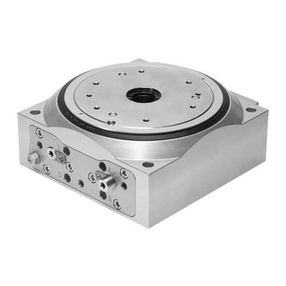
Festo
Festo DHTG User manual
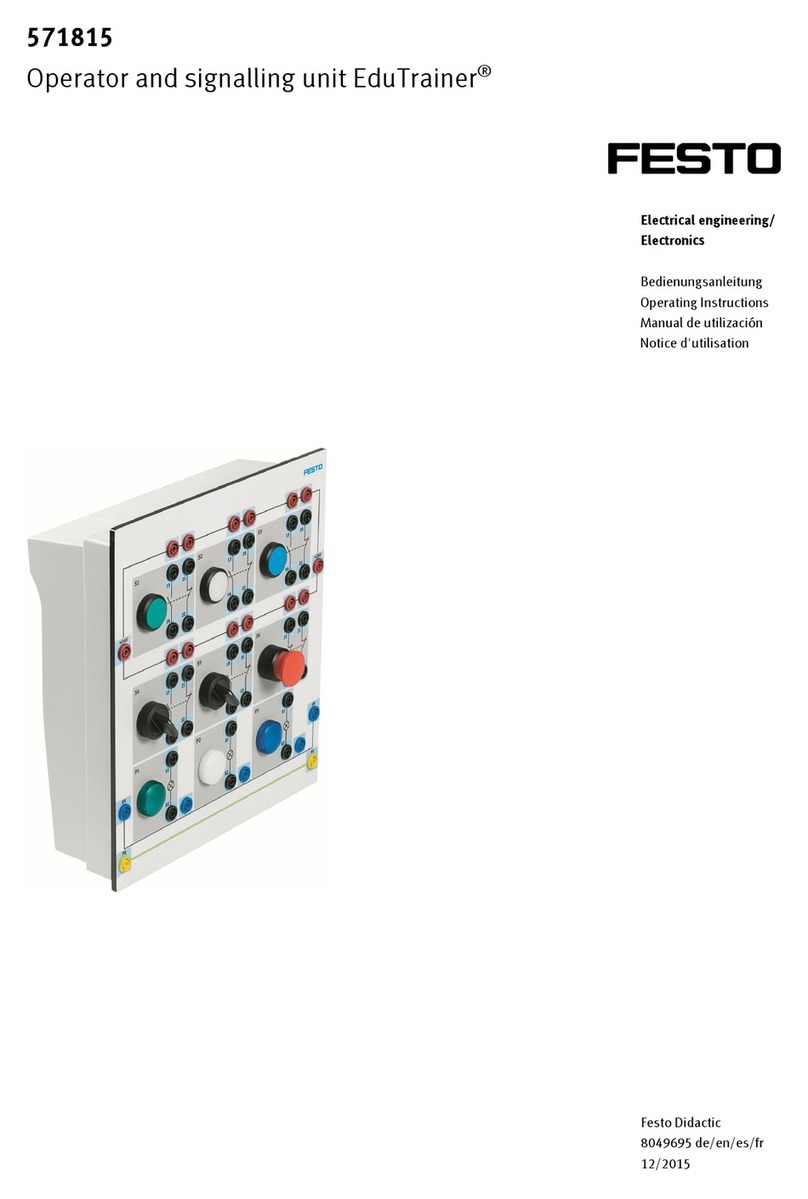
Festo
Festo 571815 User manual
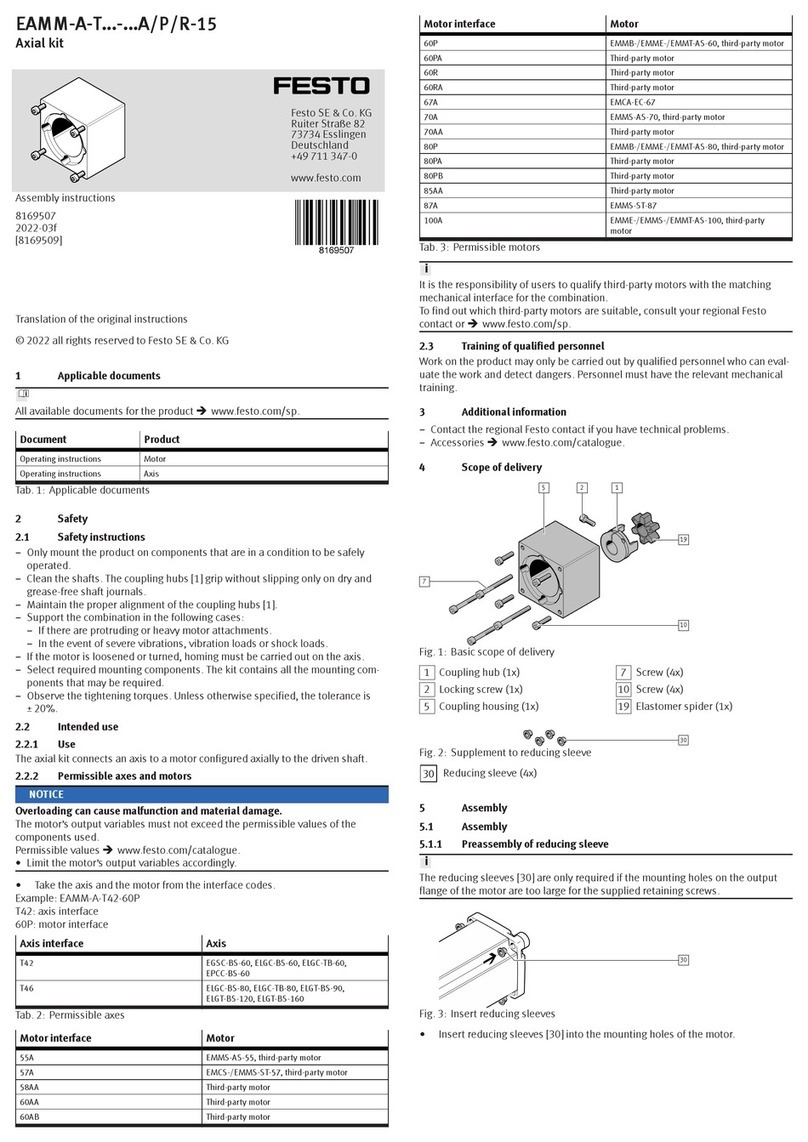
Festo
Festo EAMM-A-T42-55A User manual

Festo
Festo MPS 8033591 User manual
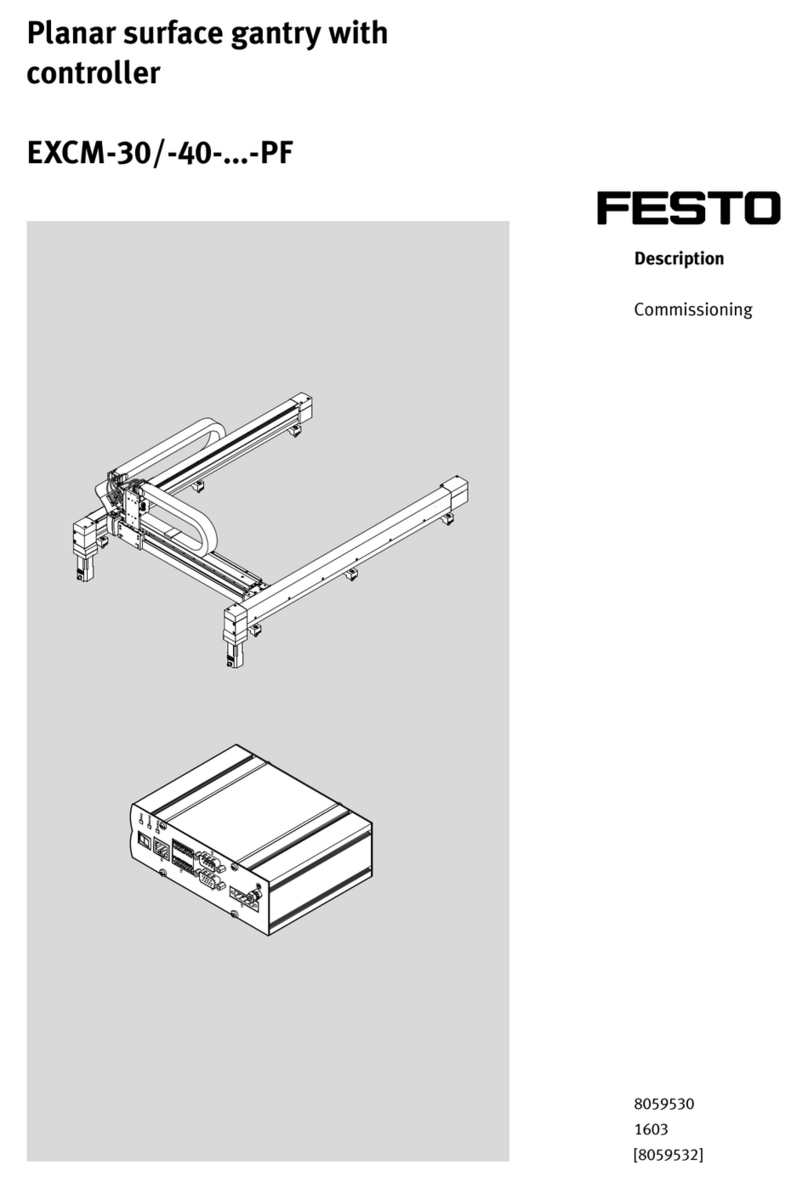
Festo
Festo EXCM-30 -PF Series User manual
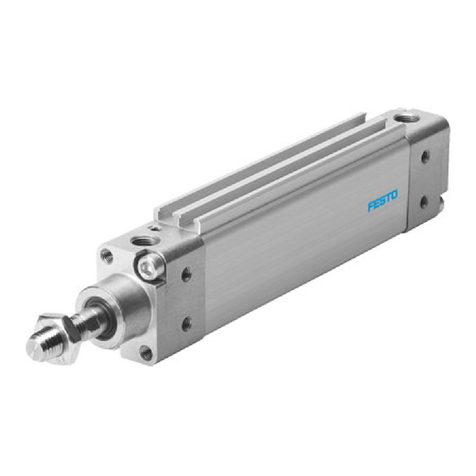
Festo
Festo DZF Setup guide
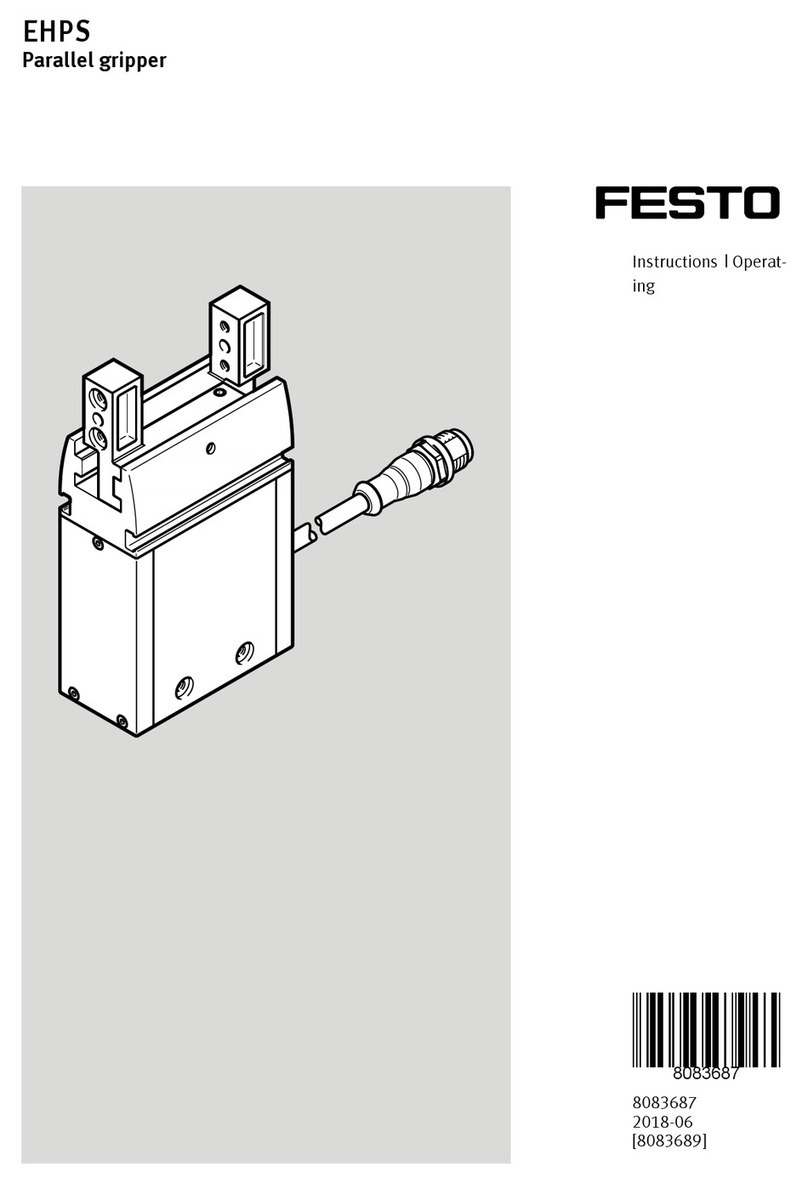
Festo
Festo EHPS-16 Parts list manual

Festo
Festo CTEU-VN User manual
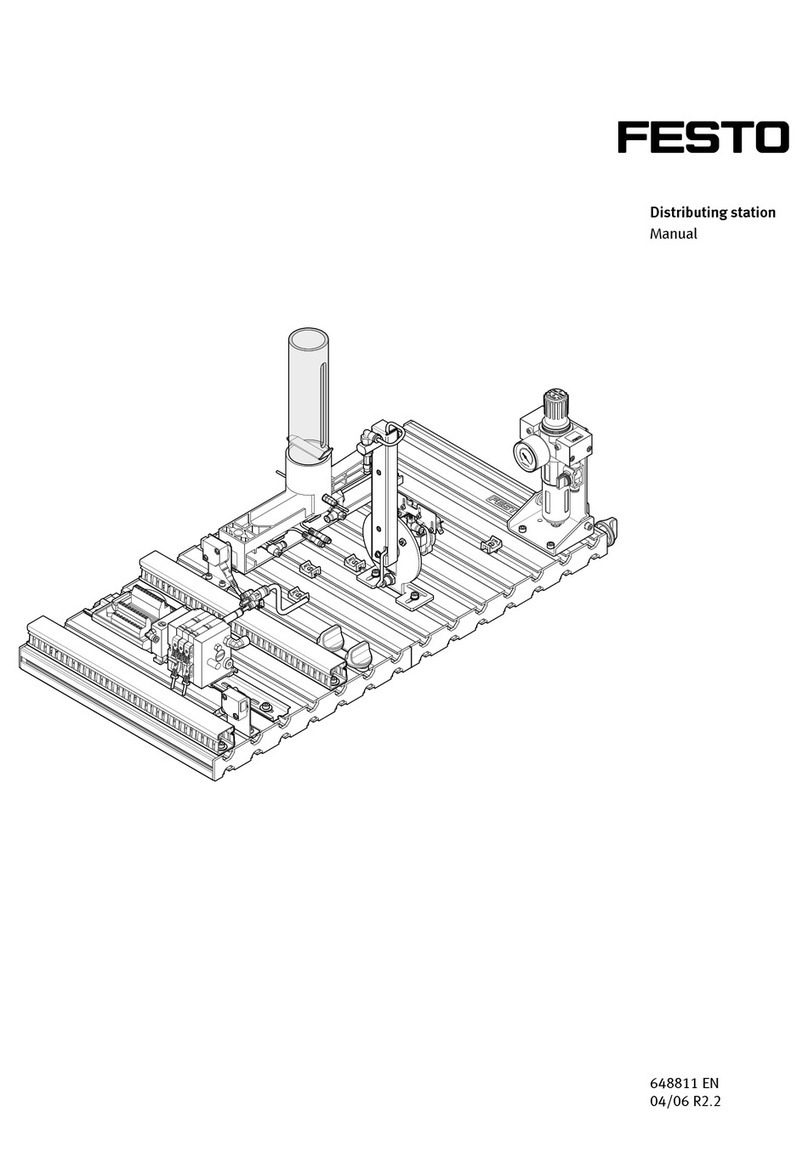
Festo
Festo Distributing Station User manual

Festo
Festo VTEM User manual
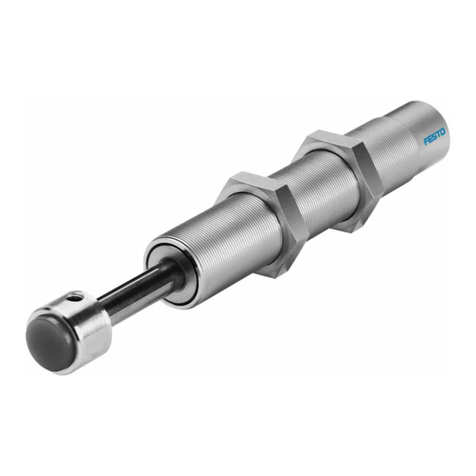
Festo
Festo YSR Series User manual
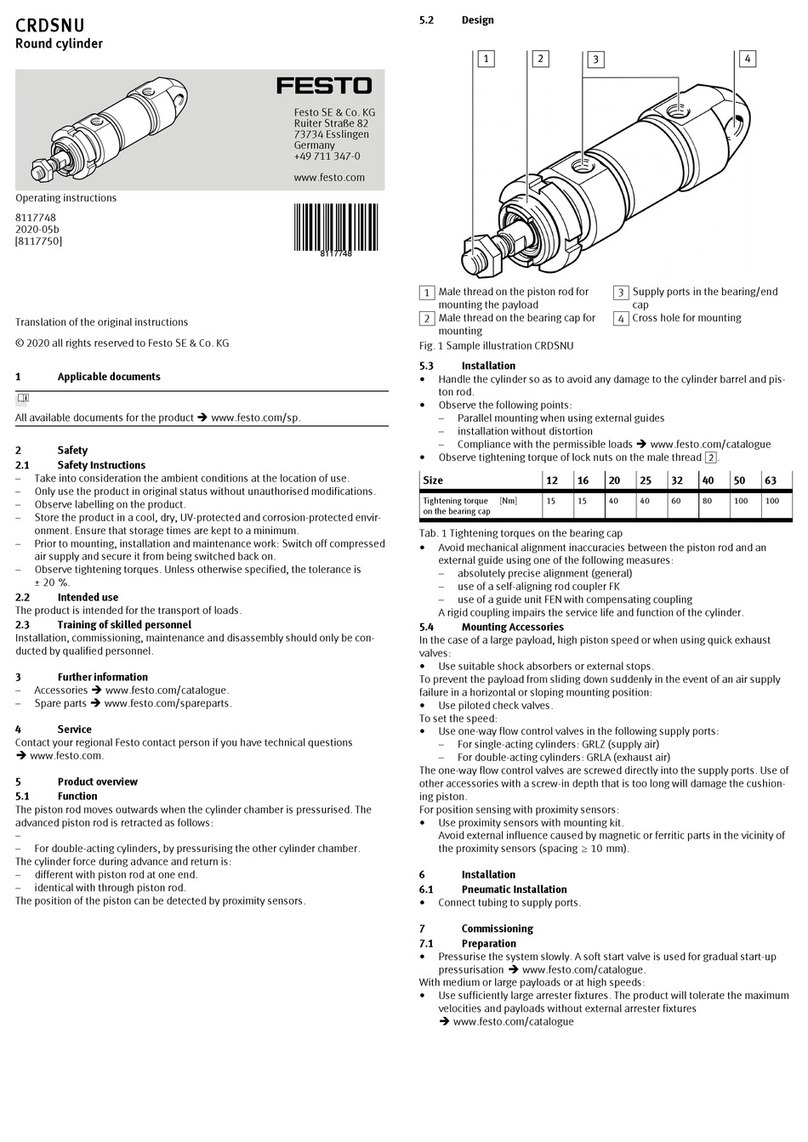
Festo
Festo CRDSNU Series User manual
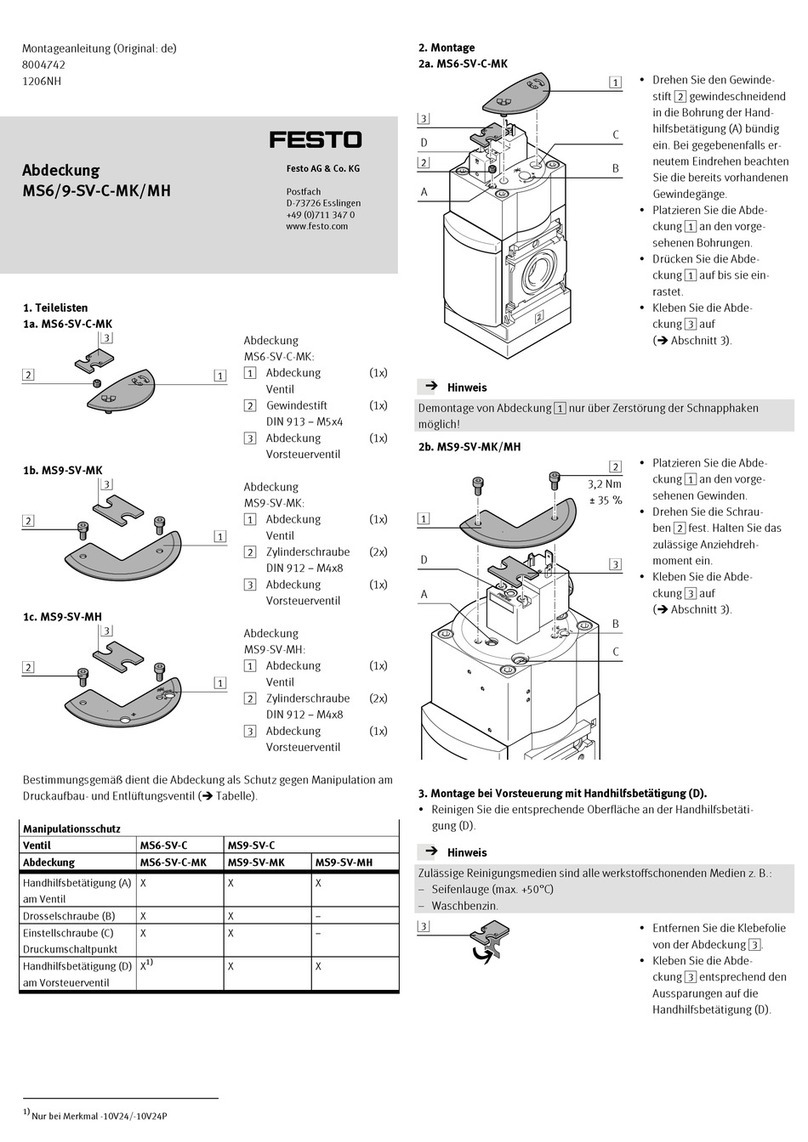
Festo
Festo MS6-SV-C-MK User manual
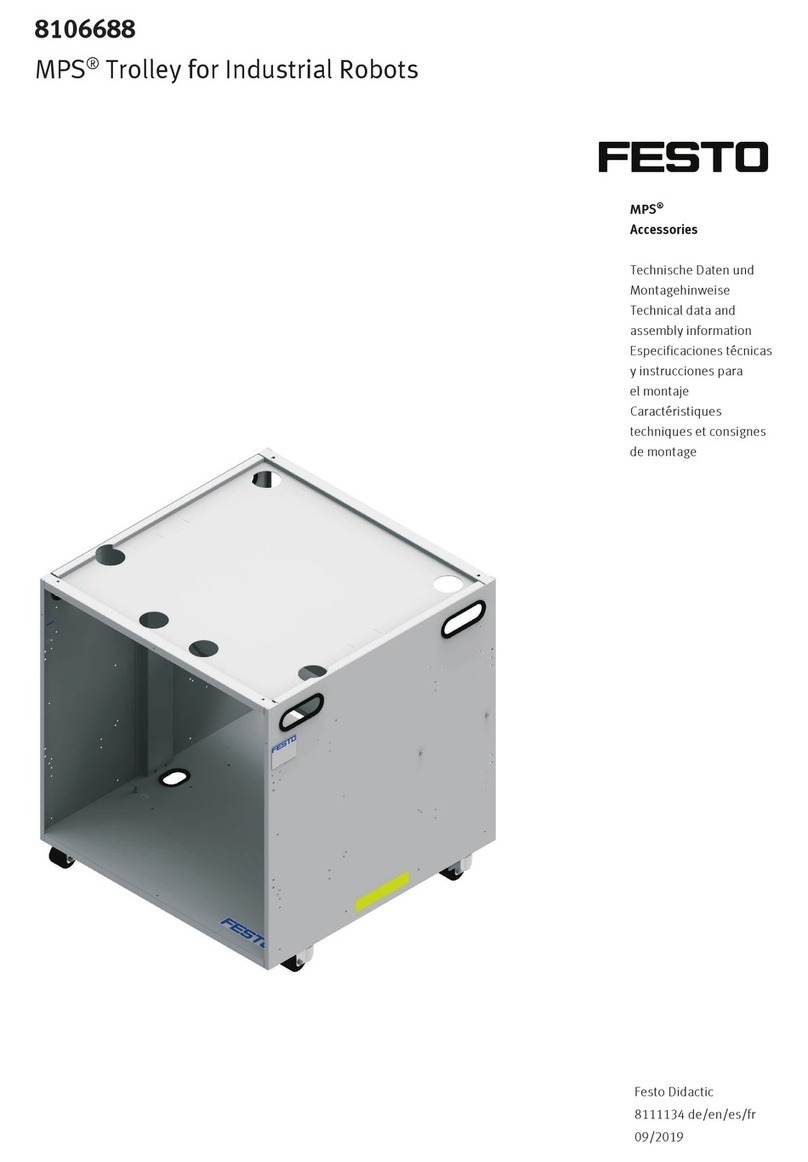
Festo
Festo MPS 8106688 Instruction manual

Festo
Festo DNCB Setup guide
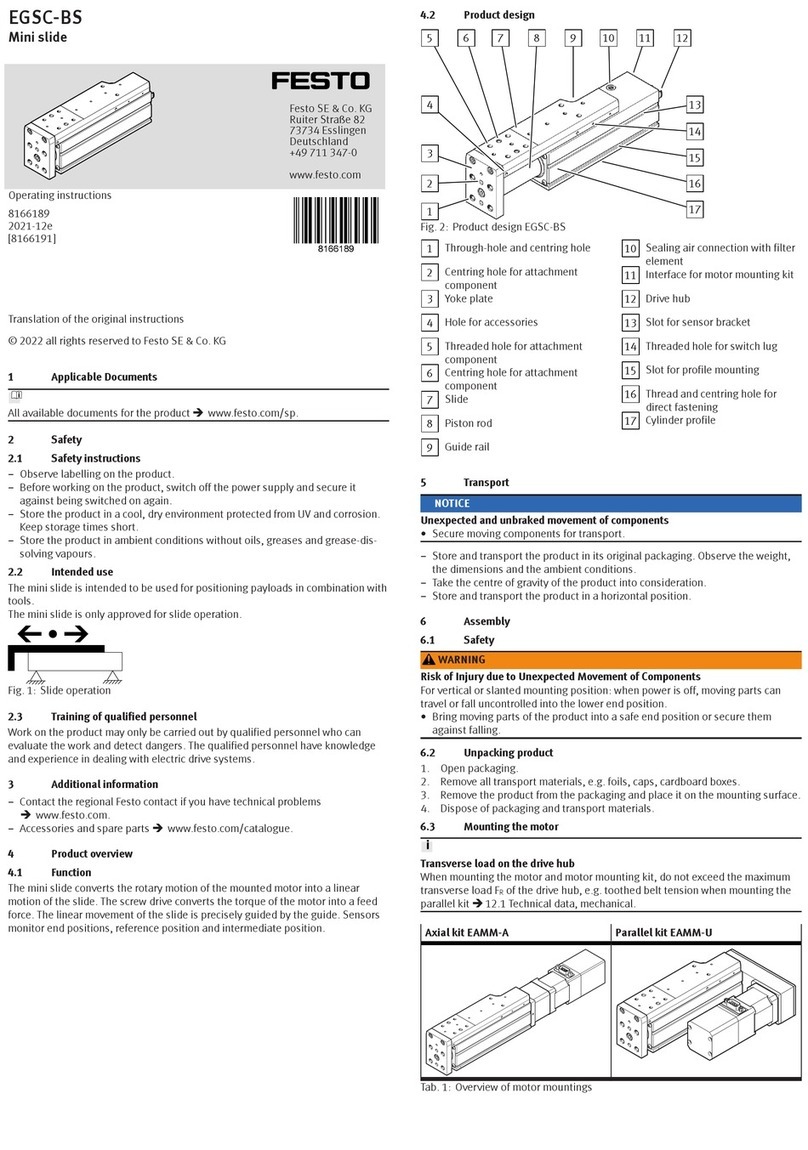
Festo
Festo EGSC-BS User manual

Festo
Festo CTEU-EC Operating and installation instructions
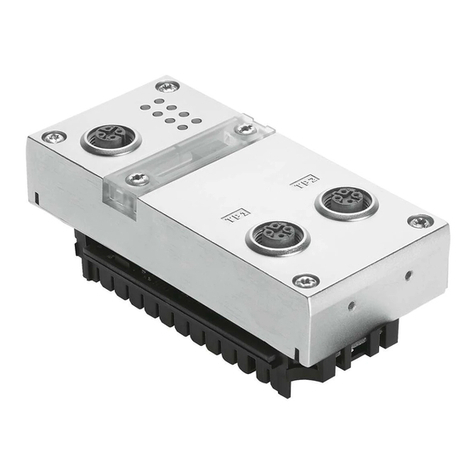
Festo
Festo CPX-FB33 User manual
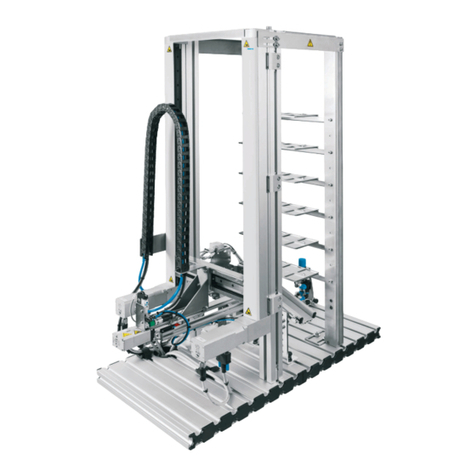
Festo
Festo MPS 8049013 User manual
